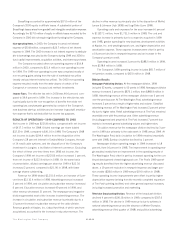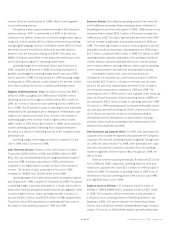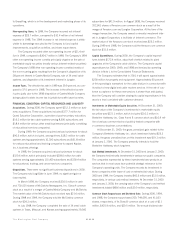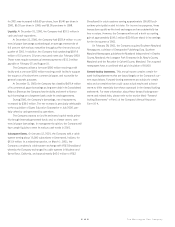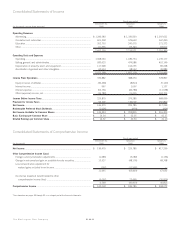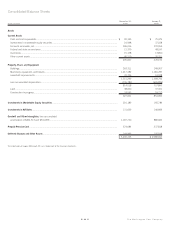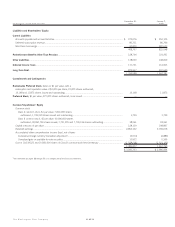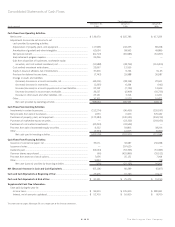Washington Post 2000 Annual Report Download - page 14
Download and view the complete annual report
Please find page 14 of the 2000 Washington Post annual report below. You can navigate through the pages in the report by either clicking on the pages listed below, or by using the keyword search tool below to find specific information within the annual report.
The Washington Post Company 39
The expected cost of providing these postretirement benefits is
accrued over the years that employees render services.
Income Taxes. The provision for income taxes is determined using the
asset and liability approach. Under this approach, deferred income taxes
represent the expected future tax consequences of temporary differences
between the carrying amounts and tax bases of assets and liabilities.
Foreign Currency Translation. Gains and losses on foreign currency
transactions and the translation of the accounts of the Company’s for-
eign operations where the U.S. dollar is the functional currency are
recognized currently in the Consolidated Statements of Income. Gains
and losses on translation of the accounts of the Company’s foreign
operations, where the local currency is the functional currency, and
the Company’s equity investments in its foreign affiliates are accumu-
lated and reported as a separate component of equity and compre-
hensive income.
Stock-based Compensation. The Company accounts for stock-based
compensation using the intrinsic value method prescribed by
Accounting Principles Board Opinion No. 25, “Accounting for Stock
Issued to Employees.” Pro forma disclosures of net income and earn-
ings per share as if the fair-value based method prescribed by
Statement of Financial Accounting Standards (SFAS) No. 123,
“Accounting for Stock-Based Compensation” had been applied in
measuring compensation expense are provided in Note G.
Sale of Subsidiary/Affiliate Securities. The Company’s policy is to
record investment basis gains arising from the sale of equity interests
in subsidiaries and affiliates that are in the early stages of building
their operations as additional paid-in capital, net of taxes.
New Accounting Pronouncements. In December 1999, the Securities
and Exchange Commission (“SEC”) issued Staff Accounting Bulletin
No. 101, “Revenue Recognition in Financial Statements (‘SAB 101’).”
This bulletin summarized certain of the SEC’s views regarding the
application of generally accepted accounting principles to revenue
recognition in financial statements. SAB 101 did not have a material
impact on the Company’s financial statements.
In June 1998, the Financial Accounting Standards Board
(“FASB”) issued Statement of Financial Accounting Standards No.
133, “Accounting for Derivative Instruments and Hedging Activities,”
effective for fiscal year 2001. This statement establishes accounting
and reporting standards for derivative instruments and hedging activi-
ties and requires companies to recognize derivative instruments as
either an asset or liability on the balance sheet at fair value. This state-
ment did not have a material impact on the Company’s financial state-
ments as the Company does not engage in significant derivative or
hedging activities.
IB IACCOUNTS RECEIVABLE AND ACCOUNTS PAYABLE AND
ACCRUED LIABILITIES
Accounts receivable at December 31, 2000 and January 2, 2000
consist of the following (in thousands):
2000 1999
Trade accounts receivable, less estimated
returns, doubtful accounts and
allowances of $65,198 and $60,621.............. $ 277,788 $ 248,279
Other accounts receivable................................. 28,228 21,985
$ 306,016 $ 270,264
Accounts payable and accrued liabilities at December 31, 2000
and January 2, 2000 consist of the following (in thousands):
2000 1999
Accounts payable and accrued expenses ......... $ 163,197 $ 158,197
Accrued payroll and related benefits................. 66,169 58,420
Deferred tuition revenue ................................... 36,414 28,060
Due to affiliates (newsprint)............................... 7,296 9,428
$ 273,076 $ 254,105
IC IINVESTMENTS
Investments in Marketable Equity Securities. Investments in marketable
equity securities at December 31, 2000 and January 2, 2000 consist
of the following (in thousands):
2000 1999
Total cost .......................................................... $ 199,159 $ 194,364
Net unrealized gains ......................................... 21,978 8,648
Total fair value................................................... $ 221,137 $ 203,012
At December 31, 2000, the Company’s ownership of 2,634
shares of Berkshire Hathaway Inc. (“Berkshire”) Class A common
stock and 9,845 shares of Berkshire Class B common stock accounted
for $210,189,000 or 95 percent of the total fair value of the Company’s
investments in marketable equity securities. The remaining invest-
ments in marketable equity securities at December 31, 2000 consist
of common stock investments in various publicly traded companies,
most of which have concentrations in Internet business activities.
In most cases, the Company obtained ownership of these common
stocks as a result of merger or acquisition transactions in which these
companies merged or acquired various small Internet-related compa-
nies in which the Company held minor investments.
Berkshire is a holding company owning subsidiaries engaged in
a number of diverse business activities; the most significant of which
consist of property and casualty insurance business conducted on
both a direct and reinsurance basis. Berkshire also owns approxi-
mately 18 percent of the common stock of the Company. The chair-
man, chief executive officer, and largest shareholder of Berkshire,


